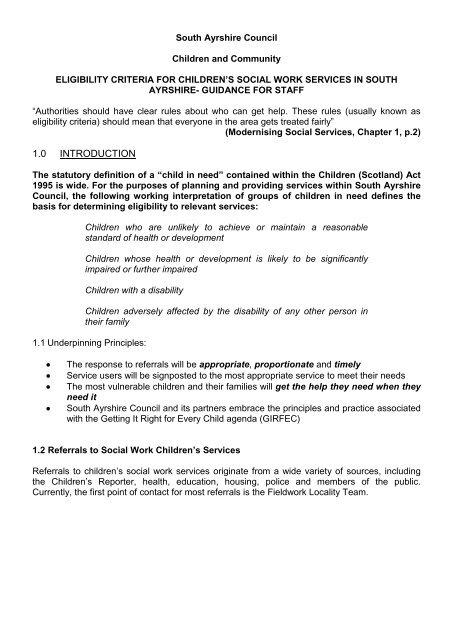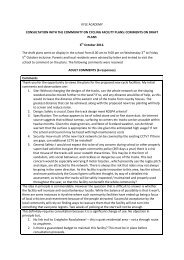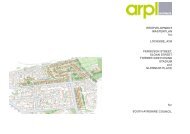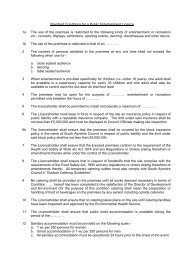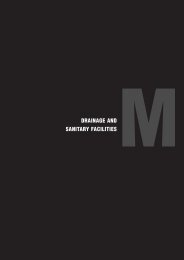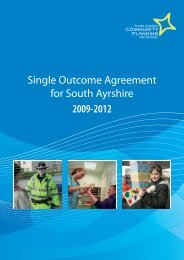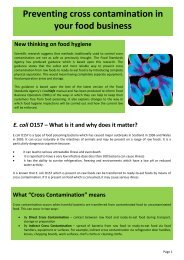Eligibility Criteria â Guidance for Staff - South Ayrshire Council
Eligibility Criteria â Guidance for Staff - South Ayrshire Council
Eligibility Criteria â Guidance for Staff - South Ayrshire Council
You also want an ePaper? Increase the reach of your titles
YUMPU automatically turns print PDFs into web optimized ePapers that Google loves.
<strong>South</strong> <strong>Ayrshire</strong> <strong>Council</strong><br />
Children and Community<br />
ELIGIBILITY CRITERIA FOR CHILDREN’S SOCIAL WORK SERVICES IN SOUTH<br />
AYRSHIRE- GUIDANCE FOR STAFF<br />
“Authorities should have clear rules about who can get help. These rules (usually known as<br />
eligibility criteria) should mean that everyone in the area gets treated fairly”<br />
(Modernising Social Services, Chapter 1, p.2)<br />
1.0 INTRODUCTION<br />
The statutory definition of a “child in need” contained within the Children (Scotland) Act<br />
1995 is wide. For the purposes of planning and providing services within <strong>South</strong> <strong>Ayrshire</strong><br />
<strong>Council</strong>, the following working interpretation of groups of children in need defines the<br />
basis <strong>for</strong> determining eligibility to relevant services:<br />
Children who are unlikely to achieve or maintain a reasonable<br />
standard of health or development<br />
Children whose health or development is likely to be significantly<br />
impaired or further impaired<br />
Children with a disability<br />
Children adversely affected by the disability of any other person in<br />
their family<br />
1.1 Underpinning Principles:<br />
• The response to referrals will be appropriate, proportionate and timely<br />
• Service users will be signposted to the most appropriate service to meet their needs<br />
• The most vulnerable children and their families will get the help they need when they<br />
need it<br />
• <strong>South</strong> <strong>Ayrshire</strong> <strong>Council</strong> and its partners embrace the principles and practice associated<br />
with the Getting It Right <strong>for</strong> Every Child agenda (GIRFEC)<br />
1.2 Referrals to Social Work Children’s Services<br />
Referrals to children’s social work services originate from a wide variety of sources, including<br />
the Children’s Reporter, health, education, housing, police and members of the public.<br />
Currently, the first point of contact <strong>for</strong> most referrals is the Fieldwork Locality Team.
2.0 ASSESSMENT AND ALLOCATION<br />
2.1 Duty referrals<br />
When a child is referred to Social Work Children’s Services, the referral will be passed to the<br />
duty worker who is responsible <strong>for</strong> the initial gathering of in<strong>for</strong>mation <strong>for</strong>m universal services,<br />
any specialist service linked to the child, and previous referrals to Social Work Services.<br />
The duty worker will then record all the relevant in<strong>for</strong>mation on SWIS and provide an initial<br />
assessment of the key issues/concerns and make a recommendation on what action they<br />
assess is required. Child protection referrals are given the highest priority and when a child<br />
protection referral is received the duty worker must discuss it immediately with the duty<br />
manager. If the duty manager is unavailable the duty worker must locate another manager to<br />
discuss the referral with.<br />
2.2 Duty manager responsibility<br />
The duty manager will prioritise referrals in accordance with the eligibility criteria<br />
Any cases not allocated must be kept under review on a weekly basis by the Team Leader <strong>for</strong><br />
the relevant locality.<br />
Any further referrals must be considered and reprioritised as required. Business meetings<br />
between managers should consider any cases that are unallocated and decide what action is<br />
required if delivery of service is not possible within the locality and or family centre intervention<br />
is required.<br />
2.3 Response Timescales<br />
Our aims:-<br />
Within 24 hours of the<br />
time of referral<br />
Within a period of 10<br />
working days<br />
Within a further 10<br />
working days<br />
Within a period of 12<br />
weeks from the date of<br />
allocation.<br />
A decision will be made about the level of need, if any. It<br />
may be determined <strong>for</strong> example that no further action is<br />
necessary<br />
In cases at the medium or high priority need level, an<br />
initial assessment and accompanying work plan will be<br />
undertaken and completed with a view to allocating or<br />
transferring to the appropriate service thereafter. Referral<br />
response letter will be triggered to the referring agency or<br />
individual regarding the referral outcome.<br />
Where it becomes apparent to the duty manager that<br />
longer-term social work involvement is necessary, he/she<br />
is to discuss transfer or arrange to allocate directly to a<br />
named worker<br />
A comprehensive social work assessment in relation to<br />
medium and high priority need cases will be completed.<br />
Proposed introduction of CAP as part of GIRFEC<br />
Practice Model implementation.
3.0 THE ELIGIBILITY CRITERIA<br />
The <strong>Eligibility</strong> <strong>Criteria</strong> are intended to provide a useful guide <strong>for</strong> social work teams in terms of<br />
managing workloads and competing demands in an equitable manner. It is recognised that there<br />
will continue to be tensions between managing priorities within existing caseloads on the one<br />
hand, and new referrals on the other; the criteria provide an objective and transparent basis <strong>for</strong><br />
allocating resources according to priority needs.<br />
3.1 High Priority Need<br />
For these children, there will be serious concern about their care, health and/or<br />
development; they will have suffered or be likely to suffer significant harm. There might<br />
also be a serious risk of family breakdown.<br />
The following examples are not exhaustive but rather are meant to be indicative of factors<br />
giving rise to high priority need.<br />
HIGH PRIORITY NEED(1)<br />
• Children and Young People with a high level of special needs or disability<br />
requiring constant supervision, and where there is a high risk of family<br />
breakdown;<br />
• Situations where the physical care or supervision of a child or young<br />
person is severely neglected;<br />
HEALTH<br />
• Children and young people involved in serious substance misuse requiring<br />
high level intervention determined by dust tool assessment.<br />
• Children and young people who have presented at accident and<br />
emergency as a result of substance misuse.<br />
• Children and young people who seriously self harm (determined by<br />
method, frequency and severity) and who experience<br />
SOCIAL,<br />
EMOTIONAL<br />
BEHAVIOURAL<br />
&<br />
• Children with severe challenging behaviour which results in serious risk to<br />
the child or others which parents are unable to manage and which results<br />
in a high risk of family breakdown.<br />
• Children and people where police assistance has been called to resolve<br />
behavior issues at home.<br />
• Children and young people who exhibit sexually inappropriate behavior.<br />
• Children and young people who are involved in offending behvaiour and<br />
are considered to be high risk or above in terms of re-offending.<br />
• Children or young people who are involved in solemn court proceedings<br />
and have been charged with indictable offences.<br />
• Children and young people who are experiencing acute emotional<br />
rejection by parents or carers including unrealistic expectations,<br />
scapegoating and inconsistent parenting;<br />
• Children and young people who have moved from another authority where<br />
they are/ were subject to child protection procedures.<br />
• Children and young people who are severely disaffected not engaged in
any educational provision.<br />
• Children and young people needing to be looked after out with their own family;<br />
FAMILY &<br />
SOCIAL<br />
RELATIONSHIPS<br />
• Children and young people where there has been a breakdown of the<br />
relationship with parent/carer leading to alternative provision <strong>for</strong> care<br />
being required.<br />
• Children and young people who are homeless.<br />
• Child or young person with a disability where the parent/carer is unable to<br />
cope and they are accommodated.<br />
• The child or young person is living in an environment where there is the<br />
presence or risk of extreme domestic violence;<br />
CHILD’S<br />
ENVIRONMENT<br />
• Home environment or hygiene issues places the child or young person at<br />
immediate risk of significant harm.<br />
• Children and young people who are returning home from secure or<br />
residential care settings.<br />
PARENTAL<br />
FACTORS<br />
• Parents/carer are suffering from severe physical or mental health<br />
problems or learning disability and are failing to adequately care <strong>for</strong> the<br />
child;<br />
• Where alcohol or drugs is significantly impacting on the ability of<br />
parents/carers to look after the child/children.<br />
3.2 Medium Priority Need<br />
For children in this category, a reasonable standard of health and development is<br />
unlikely to be maintained without family support. The child may move into the high<br />
priority category without the provision of services.<br />
There are identifiable factors which indicate that considerable deterioration is likely<br />
without support. This may include children who have been assessed as high priority in<br />
the recent past. All children referred to the Children’s Reporter will be viewed as medium<br />
priority unless their assessed needs place them in the high priority need category.<br />
MEDIUM PRIORITY NEED (2)<br />
• Children and young people living in an environment which could pose a<br />
risk to their safety or well-being;<br />
HEALTH<br />
• Children with a significant level of additional support/complex needs,<br />
who require support from outside agencies to meet their need;<br />
• The physical care or supervision of the child is inadequate;<br />
• Children and young people who self harm;<br />
• Child or young person whose substance misuse is assessed to be
medium risk ( Dust tool analysis.)<br />
• Children who are not adequately protected or looked after.<br />
SOCIAL,<br />
EMOTIONAL<br />
BEHAVIOURAL<br />
&<br />
• Children and young people with challenging behaviour whose parents<br />
are unable to cope without the provision of support;<br />
• Multiple school exclusion and where the child or young person needs<br />
educational placement out with mainstream provision<br />
• Children and young people involved in offending behaviour leading to<br />
the involvement of the courts or Children’s Hearing;<br />
• Children and young people with caring responsibilities <strong>for</strong> others that<br />
are affecting their own development.<br />
• Children and young people who have experienced acute loss and<br />
separation through their development.<br />
• Children who may have to be looked after out with their family;<br />
• Children and young people who require housing support.<br />
FAMILY & SOCIAL<br />
RELTIONSHIPS<br />
• Children who young people have previously been Looked After and<br />
who now require throughcare/aftercare services;<br />
• Children where there is a risk of family breakdown with and who require<br />
support to mediate,<br />
• Children experiencing several carers within their family network,<br />
creating inconsistency and insecurity <strong>for</strong> the child.<br />
CHILD’S<br />
ENVIRONMENT<br />
• The child or young person is living in an environment where there is a<br />
history of incidents of domestic violence;<br />
• Home environment or hygiene issues could place the child or young<br />
person at risk of harm.<br />
• Parent/carer has physical disability or history of mental health problems<br />
or learning disability which affects their ability to care <strong>for</strong> the child or<br />
young person<br />
PARENTAL<br />
FACTORS<br />
• Parents/carer where alcohol or drugs is significantly impacting on their<br />
ability to parent;<br />
• Parents whose criminal and/or anti-social behaviour threatens the<br />
welfare of the child or young person,
3.3 Low Priority Need<br />
This would cover all other children including those whose needs may not be consistently<br />
met, <strong>for</strong> whom improvements in their circumstances may be desirable but there are no<br />
acute risks present. Input from social work staff is not essential to the child’s well being<br />
and such concerns as there may be can be addressed through universal services e.g.<br />
health visitor or school.<br />
LOW PRIORITY NEED (3)<br />
• Children and young people with some special needs who require<br />
referral to other services e.g. Health Visitor, Speech Therapist,<br />
Independent Travel;<br />
HEALTH<br />
• Children who show signs of behaviour which may place them at<br />
risk.<br />
• Child or young person whose substance misuse is assessed to be<br />
low risk ( Dust tool analysis.)<br />
• Children and young people who have little opportunity to meet and<br />
play with other children due to parents isolation or child’s disability.<br />
SOCIAL,EMOTIONAL<br />
& BEHAVIOURAL<br />
• Children and young people exhibiting behaviors which are<br />
appropriate to age and stage of their development where the<br />
impact of this is not significant.<br />
• Occasional school truancy or behavioural issues.<br />
• Children young people who are involved in anti-social behaviour..<br />
FAMILY & SOCIAL<br />
RELATIONSHIPS<br />
• Children experiencing inconsistent standards of parenting but<br />
whose development is not significantly impaired;<br />
• Children whose parents request advice and guidance to manage<br />
their behaviour.<br />
CHILD’S<br />
ENVIRONMENT<br />
• Parent/carers have chronic relationship difficulties which may<br />
affect the child;<br />
• The family require advice and support regarding racial harassment.<br />
• Parent/carer requires in<strong>for</strong>mation or advice to aid their continuing<br />
care of the child;<br />
PARENTAL FACTORS<br />
• Parents/carers have chronic debts due to their inability to manage<br />
their finances.
4.0 ROUTES TO ALLOCATION<br />
4.1 High Priority Need<br />
(As stated above, child protection referrals will always be given the highest priority)<br />
Children deemed as requiring intensive support are likely to be referred through the duty system,<br />
although in some cases the referral may be made to an already allocated social worker. When<br />
referred through the Duty system, the initial assessment is likely to indicate the need <strong>for</strong> a<br />
comprehensive assessment at an early stage. When this decision is made, the work will be<br />
allocated directly to a qualified social worker.<br />
When allocating social worker time and other resources the focus will be on providing a service to<br />
those whose needs have been defined as the greatest. Work in relation to medium or low priority<br />
need will only be allocated when the team Leader responsible decides that this would not<br />
jeopardise the interest of children and families defined as in high priority need.<br />
Inevitably this will mean that, on occasion, work which may be a priority <strong>for</strong> others (agencies or<br />
within our own Department) cannot be attended to immediately. There will be support from<br />
Senior Management <strong>for</strong> the team leader and social worker who have referred to the <strong>Eligibility</strong><br />
<strong>Criteria</strong> and taken a professional and balanced decision about the allocation of resources. Work<br />
with children and families in high priority need will be undertaken by qualified social<br />
workers. Other staff may be involved in specific pieces of work as agreed in the care plan<br />
but will be supervised by the qualified worker or team leader as appropriate.<br />
4.2 Medium Priority Need<br />
The most likely first point of contact will be the duty social work service. The minimum level of<br />
intervention will be the completion of an initial assessment and, in most cases, allocation away<br />
from the duty service would be envisaged so that a fuller assessment can be made and an action<br />
plan devised. In the majority of cases the work arising from the care plan is likely to be time<br />
limited, and the intervention is likely to be within a wider, multi-agency context. Work with<br />
children and families in medium priority need would include qualified social workers and<br />
unqualified support workers whose work is supervised by a Team Leader.<br />
4.3 Low Priority Need<br />
In virtually all situations outlined, a service is likely to be directly provided by the team receiving<br />
the referral. The extent of the department’s involvement is likely to vary from merely logging the<br />
in<strong>for</strong>mation from the referral to the provision of short-term social work input by the duty response.<br />
Referral on to other agencies or departments, <strong>for</strong> example to early years services, health or<br />
sector organisations, is likely to be an important component of the work. Case allocation beyond<br />
the duty social work service would not normally be anticipated. Work with children and families<br />
in low priority need will be assessed by qualified social workers who will make<br />
recommendation re appropriate interventions and services. An allocated social worker<br />
would in most cases not be part of the care and action plan, however specific and targeted<br />
services may be appropriate.


